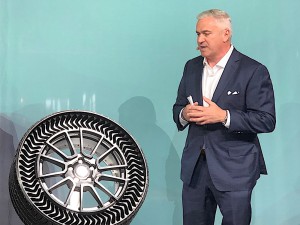
Steve Kiefer, GM’s global purchasing chief, talks about Uptis, the revolutionary new tire being tested by GM and Michelin.
The pneumatic tire revolutionized transportation, and while it might often be ignored, it’s an essential part of the modern automobile. But not for much longer, at least if a new partnership between Michelin and General Motors pans out.
GM said on Tuesday that it will begin testing the French company’s prototype wheel/tire combination, called Uptis, with a goal of putting the airless design in production by “as early as 2024.”
“I would consider it revolutionary,” said Steve Kiefer, GM’s global director of purchasing, during a news conference in Montreal on Tuesday. If it works out as well as preliminary tests indicate, “We end up with a tire that’s maintenance-free,” while matching the basic characteristics of conventional pneumatic tires.
Michelin is just one of the manufacturers who have been working on airless technology, the company initial initially introducing a concept it dubbed the “tweel” more than a decade ago.
(GM wants to be part of the solution for climate change. Click Here for the story.)
The new design follows the same basic formula, using three individual components, starting with an outer layer made of a mix of rubber and synthetic compounds that features the same sort of tread pattern as a conventional tire. But there are no sidewalls. Instead, the latest prototype developed by Michelin uses high-strength composite spokes mated to an aluminum hub that mounts to a car’s axle, just like a conventional tire.
With no sidewall, Uptis can’t be inflated, nor does it need to. The spokes serve the same purpose as the sidewalls of a conventional tires and, Michelin said can be “tuned” to work on vehicles as diverse as small sedans and big SUVs.
One of the biggest benefits would be eliminating puncture leaks and blow-outs. According to industry data show about one in five tires will undergo a loss of air pressure at some point or another each year. Improper inflation is a routine cause of premature tire wear, as well as crashes — and was blamed for hundreds of deaths involving Ford Explorers and Firestone tires two decades ago.
For automakers like GM, the new tire technology promises to lower costs, among other things allowing the elimination of spare tires and jacks. Manufacturers have turned to other alternatives, including run-flat tires that can allow a motorist to travel up to about 50 miles after losing air pressure. But these alternatives have their drawbacks. Run-flats, for example, are expensive and don’t offer the ride comfort or performance of conventional tires.
(Click Here for more about how strong sales of pricey pickups helped GM beat earnings estimate.)
Uptis potentially would translate into “less stress and more piece of mind” for a motorist, said Michelin R&D director Eric Vinesse, “knowing you won’t be stranded on the side of the road because of a flat tire.”
There also are indications that Uptis could last longer and even allow the outer rubber layer to be removed and replaced. While the trucking industry routinely retreads conventional tires, that is rarely done with passenger vehicles.
There are other potential advantages, said Vinesse, including the fact that carmakers like GM would be able to eliminate the spare tires and jacks that currently add cost and weight to their vehicles. Michelin also hopes to integrate sensors into Uptis that would constantly monitor road conditions, such as when pavement is covered with black ice.
That would be particularly useful, the two executives agreed, for use on driverless vehicles, like the ones GM’s Cruise Automation subsidiary is developing. It hopes to launch an autonomous ride-sharing service in San Francisco later this year.
(GM investing $24M in Ft. Wayne plant to boost production. Click Here for the story.)
Michelin has clocked millions of miles testing the Uptis in digital simulations and has just begun real-world testing, said Vinesse. GM now plans to accelerate that process by running the prototypes on some of the same Chevy Bolt EVs that will be used in the Cruise ride-sharing service.

Two comments are in order: 1) I trust that the concept in the photos is intended to help us understand the construction, but is not the actual proposal. With no sidewalls, the open areas of the tire will fill with dirt, stones, snow, ice, etc., and numerous problems will result. 2) In this era of CO2 consciousness, how can executives get excited about a new concept like this and not talk about mass, rotating inertia, or rolling resistance? Silence must mean these must mean these are disadvantages!
Hi, Davis, Interesting you mention point 1. It is a question I raised with the Michelin R&D chief and it is something they are clearly studying. The real-world testing should show if this actually is a problem, as I suspect it will be. Meanwhile, as to weight, I was told the target is about the same as current wheels and tires and that may be the case. Meanwhile, there will be no need for a spare or jack, they claim.
Paul E.
Hi Paul — thanks for your reply. Point 1: Having lived in Michigan my entire life, and on a dirt road for many of those years, I am confident that “stuff” will get into the openings and disrupt balance and spring rate characteristics.
Point 2: eliminating the jack and spare will do nothing to address the (potential) increases in unsprung mass and rotational inertia. I don’t see how the pros outweigh the cons.
GM and other makers do, having seen the data. Also, the increase in weight does not appear to be much, from what both GM and Michelin told me. The composite materials aren’t mass-dense and remember all that the steel in today’s radials. I do, however, agree with you on the open side question. Both companies say it is something they are looking at.